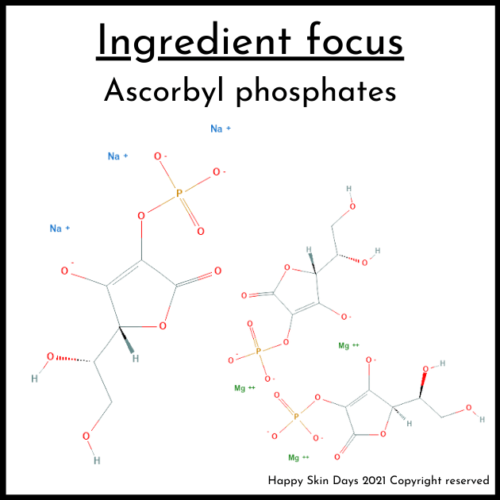In today’s blog, I am doing a deep-dive into both Magnesium and Sodium Ascorbyl phosphates, but before that, if there is anything you take away from this blog, this is my view on both derivatives:
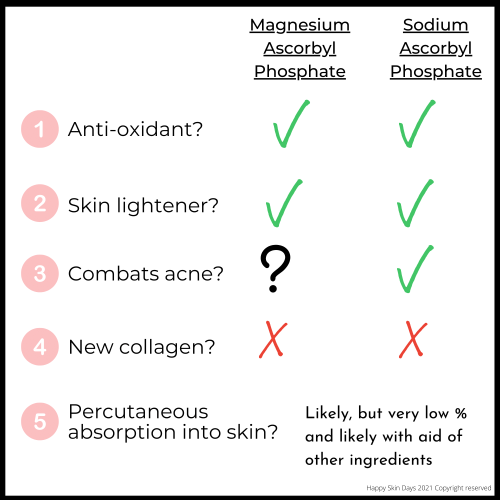
Chemical structure – Sodium Ascorbyl Phosphate

Chemical structure – Magnesium Ascorbyl Phosphate
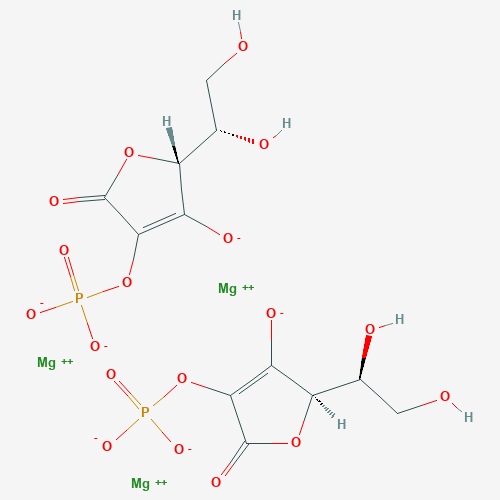
Source: pubchem
Products containing Sodium and Magnesium Ascorbyl phosphate

How is Magnesium Ascorbyl Phosphate different from L-Ascorbic Acid?
L-Ascorbic Acid is unstable and oxidizes quickly when exposed to air and quickly becomes useless when in an aqueous solution. Magnesium Ascorbyl Phosphate (SAP) is stable in water/aqueous solutions.
What characteristics of L-Ascorbic Acid do we ant SAP to replicate?
Vitamin C (L-Ascorbic Acid) on a great day achieves the following:
– its essential for the synthesis of collagen in the dermis. Topical application of L-Ascorbic Acid has been demonstrated to produce new collagen in the dermis
– it is a skin lightener, as it interferes with the enzymatic activity of tyrosinase, an enzyme that is vital for the production of the pigment (melanin) that in turn, gives skin its colour
– is an anti-oxidant and has been demonstrated to reduce reactive oxygen species on exposure to UV radiation as well as reduce subsequent photodamage.
How does MAP stack-up?
The challenge for any Vitamin C derivative is that it has to be converted to L-Ascorbic Acid, before it can be used by skin cells. This happens usually by hydrolysis of some description in the body by enzyme (s). I don’t think anyone has mapped out the entire chemical reaction in cells – and I certainly haven’t found it.
What I have been able to find is this:
1) it is a potent anti-oxidant and counters the effect of ROS caused by over-exposure to UV radiation. (That is MAP has a protective effective against skin damage induced by UVB radiation).
2) it is a skin lightener (with varying degrees of success)
3) There are no indications (or I haven’t found the independent datasets) to suggest that either Magnesium Ascorbyl Phosphate OR that Sodium Ascorbyl Phosphate contributes to the synthesis of collagen in the dermis.
What studies have I found?
There are not many studies on MAP, which I have previously explained is unsurprising (see this BLOG).
Koichiro K et al (1996) applied a cream containing 10% MAP on the skin, twice a day on 34 patients with pigmentation disorders. 19 out of these 34 patients showed lighter pigmentation and 2 out of 34 showed possible darkening (eeks!).
When the cream was applied to normally pigmented healthy skin of 25 patients, about 10 people showed lighter pigmentation. It was only slightly effective in 12 patients and there was possible darkening in 2 patients.
The percutaneous penetration of MAG was LOW (0.09% – 0.51% of applied dose). “The amount of the radio-labelled production in the entire skin after topical application of the cream was 1.58% obtained by the addition of the amount in the dermis and epidermis.“
This allowed researchers to conclude that MAG is “absorbed percutaneously and stays in the skin and inhibits tyrosinase activity of melanocytes.”
On Sodium Ascorbyl Phosphate…
1) Whitening effect of Sodium Ascorbyl Phosphate
There is a recent research paper on the anti-pigmenting effect of L-Ascorbate-2-phosphate trisodium salt (essentially SAP) on hyperpigmented facial lesion of Japanese women. Lotions with 6% SAP were applied twice daily for 24 weeks (or 6 months) on 27 Japanese women. There was a decrease in the melanin index in the hyperpigmented areas.
The authors conclude, “These findings strongly indicate that Sodium Ascorbyl Phosphate has a weak but significant anti-pigmenting effect on solar lentigos (the hyper-pigmented areas) and a significant whitening effect on normally pigmented healthy skin.“
2) Treatment of acne
Woolery-Lloyd H et al, evaluated the efficacy of 5% Sodium L-Ascorbyl-2-phosphate as a treatment of acne using 50 test subjects in double-blinded controlled trial over 12 weeks. The results showed statistically significant improvement in acne….
The underlying theory is that Sodium Ascorbyl Phosphate as a potent anti-oxidant prevents the oxidation of sebum, which may be the cause of acne in patients
3) Is a potent anti-oxidant that counters the effect of reactive oxygen species (ROS).
SAP is a very effective oxygen species scavenger and has been used by Foco A et al, to study carrier vehicles (liposomes).
What do manufacturers suggest?
On Ultroprospector, a paid subscription service, there are multiple manufacturers of both Magnesium Ascorbyl Phosphate and Sodium Ascorbyl Phosphate.
Sodium Ascorbyl Phosphate
A German manufacturer, Selco, produces a datasheet on Ultroprospector that I can access. Selco, write the efficacy as follows
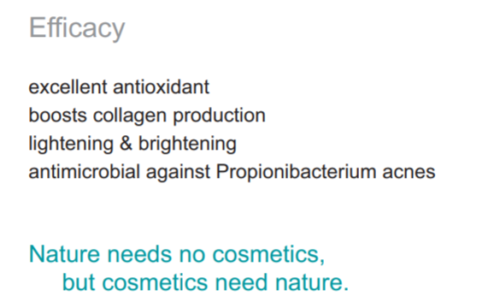
This is the entire data sheet:
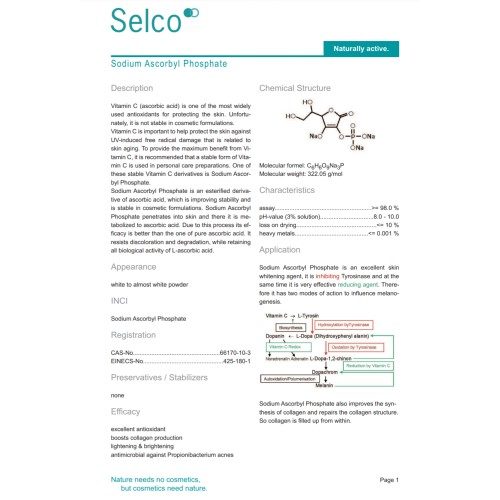

Magnesium Ascorbyl Phosphate
Owing to the region I live in, I cannot access information on MAP. I have found the Material Specification Sheet from the Shanghai OLI Enterprises Co., Ltd and this is their material specification sheet. This is from Ultroprospector’s website (a third party website, whose content I am not responsible for).
This blog was last updated on 26 July 2021 and unless otherwise stated, it will not be updated again.
Sources
Ishikawa Y et al, Whitening effect of L-ascorbate-2-phosphate trisodium salt on solar lentigos Archives of Dermatological Research 311, 183-191 (2019)
pubchem website
United States Environmental Protection Agency website
Final Report of the Safety Assessment of L-Ascorbic Acid, Calcium Ascorbate, Magnesium Ascorbate, Magnesium Ascorbyl Phosphate, Sodium Ascorbate, and Sodium Ascorbyl Phosphate as Used in Cosmetics International Journal of Toxicolgy, 24(Suppl. 2):51–111, 2005
Fočo A et al, Investigation of liposomes as carriers of sodium ascorbyl phosphate for cutaneous photoprotection International Journal of Pharmaceutics, Volume 291, Issues 1–2,2005
Koichiro K et al, Inhibitory effect of magnesium l-ascorbyl-2-phosphate on melanogenesis in vitro and in vivo. Journal of the American Academy of Dermatology, Volume 34, Issue 1, 1996
Kobayashi S et al, Protective Effect of Magnesium-L-Ascorbyl-2-Phosphate Against Skin Damage Induced by UVB Irradiation https://onlinelibrary.wiley.com/doi/abs/10.1111/j.1751-1097.1996.tb02447.x
Parvez S et al, Survey and mechanism of skin depigmenting and lightening agents Phytotherapy ResearchVolume 20, Issue 11 p. 921-934
Woolery-Lloyd H, et al. Sodium L-ascorbyl-2-phosphate 5% lotion for the treatment of acne vulgaris: a randomized, double-blind, controlled trial. J Cosmet Dermatol. 2010 Mar;9(1):22-7
